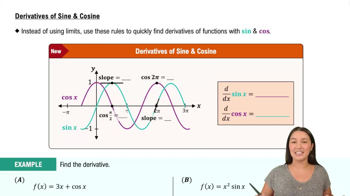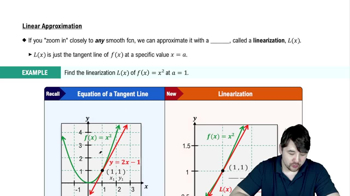b. Slopes on a tangent curve What is the smallest value the slope of the curve can ever have on the interval −2 < x < 2? Give reasons for your answer.
Table of contents
- 0. Functions7h 54m
- Introduction to Functions16m
- Piecewise Functions10m
- Properties of Functions9m
- Common Functions1h 8m
- Transformations5m
- Combining Functions27m
- Exponent rules32m
- Exponential Functions28m
- Logarithmic Functions24m
- Properties of Logarithms36m
- Exponential & Logarithmic Equations35m
- Introduction to Trigonometric Functions38m
- Graphs of Trigonometric Functions44m
- Trigonometric Identities47m
- Inverse Trigonometric Functions48m
- 1. Limits and Continuity2h 2m
- 2. Intro to Derivatives1h 33m
- 3. Techniques of Differentiation3h 18m
- 4. Applications of Derivatives2h 38m
- 5. Graphical Applications of Derivatives6h 2m
- 6. Derivatives of Inverse, Exponential, & Logarithmic Functions2h 37m
- 7. Antiderivatives & Indefinite Integrals1h 26m
- 8. Definite Integrals4h 44m
- 9. Graphical Applications of Integrals2h 27m
- 10. Physics Applications of Integrals 3h 16m
- 11. Integrals of Inverse, Exponential, & Logarithmic Functions2h 31m
- 12. Techniques of Integration7h 41m
- 13. Intro to Differential Equations2h 55m
- 14. Sequences & Series5h 36m
- 15. Power Series2h 19m
- 16. Parametric Equations & Polar Coordinates7h 58m
3. Techniques of Differentiation
The Chain Rule
Problem 3.6.3
Textbook Question
Derivative Calculations
In Exercises 1–8, given y = f(u) and u = g(x), find dy/dx = f'(g(x)) g'(x).
y = sin u, u = 3x + 1
 Verified step by step guidance
Verified step by step guidance1
First, identify the functions involved: y = sin(u) and u = 3x + 1. We need to find dy/dx using the chain rule.
The chain rule states that dy/dx = dy/du * du/dx. So, we need to find the derivatives dy/du and du/dx separately.
Calculate dy/du: Since y = sin(u), the derivative of y with respect to u is dy/du = cos(u).
Calculate du/dx: Since u = 3x + 1, the derivative of u with respect to x is du/dx = 3.
Combine the derivatives using the chain rule: dy/dx = dy/du * du/dx = cos(u) * 3. Substitute u = 3x + 1 into the expression to get dy/dx = cos(3x + 1) * 3.
 Verified video answer for a similar problem:
Verified video answer for a similar problem:This video solution was recommended by our tutors as helpful for the problem above
Video duration:
2mPlay a video:
Was this helpful?
Key Concepts
Here are the essential concepts you must grasp in order to answer the question correctly.
Chain Rule
The chain rule is a fundamental differentiation technique used when dealing with composite functions. It states that if you have a function y = f(u) and u = g(x), then the derivative dy/dx is found by multiplying the derivative of f with respect to u, f'(u), by the derivative of u with respect to x, g'(x). This allows us to differentiate complex functions by breaking them down into simpler parts.
Recommended video:

Intro to the Chain Rule
Derivative of Sine Function
The derivative of the sine function, sin(u), with respect to u is cos(u). This is a basic derivative rule in calculus, which is essential for solving problems involving trigonometric functions. When applying the chain rule, knowing the derivative of sin(u) helps in finding the derivative of composite functions involving sine.
Recommended video:

Derivatives of Sine & Cosine
Linear Function Derivative
The derivative of a linear function u = 3x + 1 with respect to x is simply the coefficient of x, which is 3. Linear functions are straightforward to differentiate, and understanding this concept is crucial when applying the chain rule to find dy/dx for composite functions where one part is linear.
Recommended video:

Linearization

 5:02m
5:02mWatch next
Master Intro to the Chain Rule with a bite sized video explanation from Patrick
Start learningRelated Videos
Related Practice
Textbook Question
